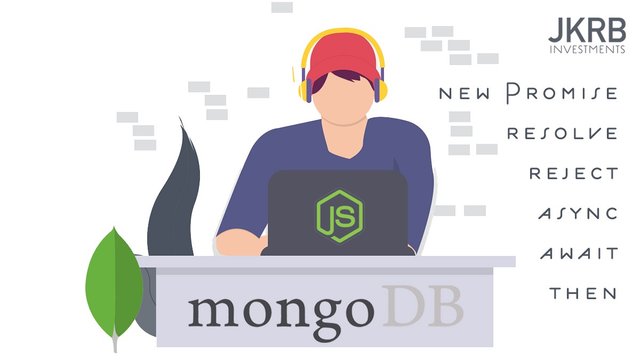
How to handle API requests with a chain of MongoDB queries
You are writing a backend service for your web app and you need to fetch data from your mongo cluster. The problem is, you do not want your request to be returned in a synchronous manor — instead I want mongo queries to be carried out, get the returned result, handle it, and return the JSON to my front end when it is ready.
You want to conform to ES6/7 javascript standards to maintain your app code and stay relevant; you need to implement promises, async and await functionality, wrapped around your db.collection mongo requests.
Breaking down the process
Before the full example and explanation of a fully-fledged asynchronous API request, I want to briefly revisit promises and using async/await in javascript.
Promise
Promises give us a way to handle asynchronous processing in a more synchronous fashion. They represent a value that we can handle at some point in the future; it will eventually be returned, or resolved.
If we call a promise and console.log it, we will be greeted with a pending promise. The promise has not yet been resolved. It is in the middle of completing what we code it to do. When it has resolved we will be able to retreive the data we originally intended the promise to return to us.
Promises are immutable, the handler cannot be changed. We are also guaranteed to receive a return value, either what we intended, or an error.
We will write our promises inside ES6 functions, and then asynchronously call it using await and async.
What does a promise look like? Something like this:
var myPromise = () => {
return new Promise((resolve, reject) => {
//do something, fetch something....
//you guessed it, mongo queries go here.
db.collection('your_collection').find(...)
//I can continue to process my result inside my promise
.then(function(result){
//another query can be called based on my result...
return updatedResult;
})
//This promise may take a while...
.then(function(result){
//when you are ready, you can resolve the promise.
resolve(result);
});
});
};
Notice the second handler (typically named reject). It is a function to call to reject the promise if it can't resolve the future value.
We could expand the previous psuedocode to account for rejecting unwanted data:
//when you are ready, you can resolve the promise.
var somethingWentWrong = (dataReturned == null);
if(somethingWentWrong ?
reject('something messed up') :
resolve(result));
Now let's move onto asynchronously processing our promises.
async / await
As you can see, the async and await keywords are absent from our Promise code. We use them to configure an asynchronous function that will call our promise, and wait for it to complete, like this:
var callMyPromise = async () => {
var result = await (myPromise());
return result;
};
See how simple that was? Some articles online make the process look rather complicated. It is not — separate your promise declarations and your asynchronous functions. Make things simple to read and build upon; your team will appreciate it.
So the last piece of the puzzle is to coherently put everything together so we can finally return our API request, which looks something like this:
callMyPromise().then(function(result) {
//close mongo client
client.close();
//feel free to process your final result before sending
//it back to your front end
//return the API request
res.json(result);
});
Putting everything together
Let's put everything we just went through together to create a full API request. Let’s say I am using Express as my backend service.
Notice the router handler is asynchronous too, declaring async before my handler.
router.post('/api/get_data', async (req, res, next) => {
try {
await MongoClient.connect(connectionStr, mongoOptions, function(err, client) {
assert.equal(null, err);
const db = client.db('db');
//Step 1: declare promise
var myPromise = () => {
return new Promise((resolve, reject) => {
db.collection('your_collection').find({id: 123})
.limit(1)
.toArray(function(err, data) {
if(err ? reject(err) : resolve(data[0]));
});
});
};
//Step 2: async promise handler
var callMyPromise = async () => {
var result = await (myPromise());
return result;
};
//Step 3: make the call
callMyPromise().then(function(result) {
client.close();
res.json(result);
});
}); //end mongo client
} catch (e) {
next(e)
}
});
module.exports = router;
Some points about this example:
Router handler is asynchronous, and I am awaiting my MongoClient with
await MongoClient.connectThe entire process is wrapped in a
trycatchso I can handle any errors that occur.res.jsonreturns the result of my data as a JSON object.